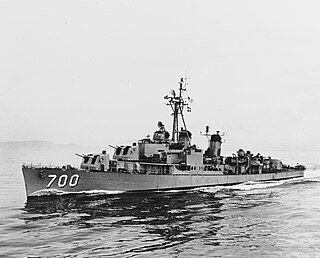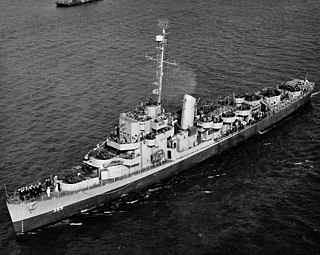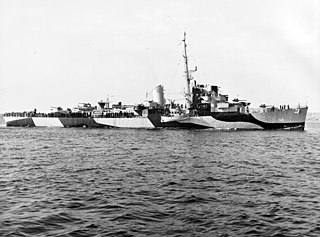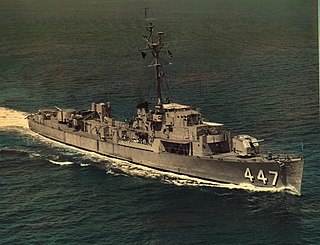
USS McGinty (DE-365) was a John C. Butler-class destroyer escort of the United States Navy.

USS Goff (DD-247) was a United States Navy Clemson-class destroyer in commission from 1921 to 1931 and from 1932 to 1945. She saw service during the Second Nicaraguan Campaign and World War II. She was named for Secretary of the Navy Nathan Goff, Jr.

USS Kimberly (DD-521) was a Fletcher-class destroyer in service with the United States Navy from 1943 to 1947, then from 1951 to 1954. In 1967, she was transferred to the Republic of China Navy where she served as ROCS An Yang (DD-18/DDG-918) until 1999. The destroyer was sunk as a target in 2003.

USS Haynsworth (DD-700), was an Allen M. Sumner-class destroyer of the United States Navy.

USS Hissem (DE-400/DER-400) was an Edsall class destroyer escort of the United States Navy. Hissem was constructed in 1943 as DE-400. In 1955, the vessel was equipped with modern radars, and the designation was changed to DER-400. The special purpose of DER ships was the detection of aircraft. Their chief role was to extend the DEW line out into the N. Atlantic and the N. Pacific oceans.

USS Reeves (DE-156/APD-52) was a Buckley-class destroyer escort in service with the United States Navy from 1943 to 1946. She was transferred to Ecuador for use as an electric generator plant in 1960. Her final fate is unknown.

USS Darby (DE-218) was a Buckley-class destroyer escort in service with the United States Navy from 1943 to 1947 and from 1950 to 1968. She was sunk as a target in 1970.

USS Stockdale (DE–399) was an Edsall-class destroyer escort in service with the United States Navy from 1943 to 1947. She was sunk as a target in 1974.
The second USS Dempsey (DE-26) was an Evarts-class destroyer escort constructed for the United States Navy during World War II. She was promptly sent off into the Pacific Ocean to protect convoys and other ships from Japanese submarines and fighter aircraft. By the end of the ship's World War II service career, when she returned to the United States, she had accumulated three battle stars.

USS Kyne (DE-744) was a Cannon-class destroyer escort built for the United States Navy during World War II. She served in the Pacific Ocean and provided escort service against submarine and air attack for Navy vessels and convoys. She earned six battle stars during the war.

USS Roberts (DE-749) was a Cannon-class destroyer escort in service with the United States Navy from 1943 to 1968. She was later sunk as a target in 1971.

USS Hurst (DE-250) was an Edsall-class destroyer escort in service with the United States Navy from 1943 to 1946. The ship served in both the Atlantic and the Pacific and was decommissioned in May 1946 and placed in reserve for the next 27 years.

USS Harveson (DE-316) was an Edsall-class destroyer escort built for the U.S. Navy during World War II. She served in the Atlantic Ocean the Pacific Ocean and provided destroyer escort protection against submarine and air attack for Navy vessels and convoys.

USS Kirkpatrick (DE-318) was an Edsall-class destroyer escort built for the U.S. Navy during World War II. She served in the Atlantic Ocean the Pacific Ocean and provided destroyer escort protection against submarine and air attack for Navy vessels and convoys. Post-war, she was converted to a radar picket ship to support the DEW Line.

USS Strickland (DE-333) was an Edsall-class destroyer escort in service with the United States Navy from 1944 to 1946 and from 1952 to 1959. She was sold for scrapping in 1974.

USS Raymond (DE-341) was a John C. Butler-class destroyer escort acquired by the U.S. Navy during World War II. The purpose of the destroyer escort was primarily to escort and protect ships in convoy, in addition to other tasks as assigned, such as patrol or radar picket. Post-war, she returned home with five battle stars to her credit, including credit for her striking a Japanese cruiser with her 5-inch (127 mm) guns during the Battle off Samar. The destroyer escort was named for Reginald Marbury Raymond, who was killed by enemy gunfire on 30 April 1943 aboard USS Scorpion.

USS Albert T. Harris (DE-447) was a John C. Butler-class destroyer escort acquired by the U.S. Navy during World War II. The primary purpose of the destroyer escort was to escort and protect ships in convoy, in addition to other tasks as assigned, such as patrol or radar picket. Post-war she returned home with two battle stars to her credit.

USS Hollis (DE-794/APD-86) was a Buckley-class destroyer escort in service with the United States Navy from 1944 to 1947 and from 1951 to 1956. She was scrapped in 1975.

USS Loeser was a Buckley-class destroyer escort of the United States Navy, named in honor of Lieutenant Commander Arthur E. Loeser (1903–1942).

USS Register (APD-92), ex-DE-233, was a United States Navy high-speed transport in commission from 1945 to 1946.



















